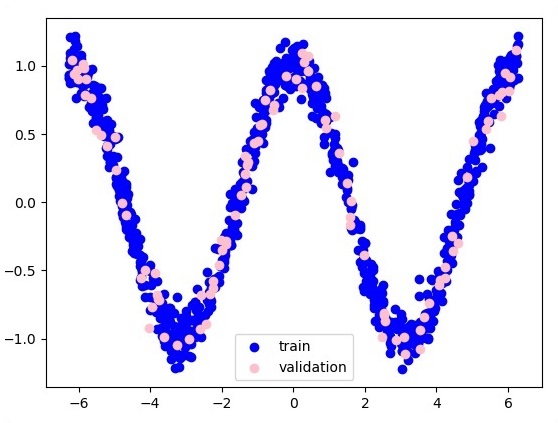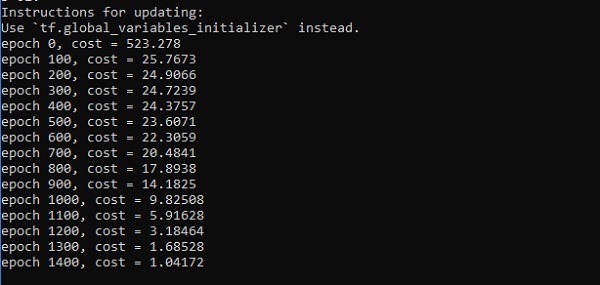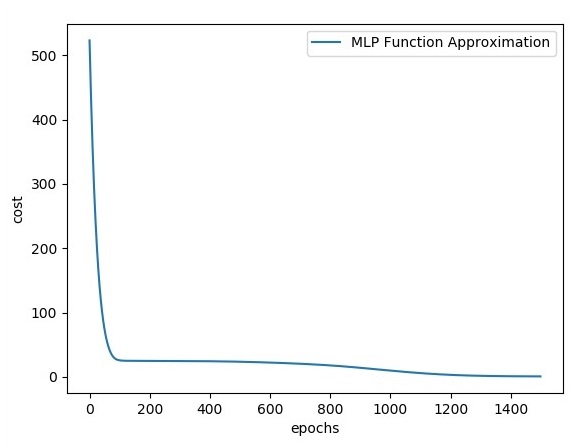📌 相关文章
- 使用Perceptron网络的OR门
- 使用Perceptron网络的OR门(1)
- 如何隐藏 tensorflow 警告 (1)
- perceptron multicouche scratch python (1)
- perceptron multicouche scratch python 代码示例
- TensorFlow 2.0
- TensorFlow 2.0
- TensorFlow 2.0(1)
- TensorFlow 2.0(1)
- 如何隐藏 tensorflow 警告 - 无论代码示例
- TensorFlow中的隐藏层感知器
- tensorflow - Python (1)
- 隐藏在C#中的方法
- 隐藏在C#中的方法(1)
- 隐藏类 - Html (1)
- 什么是Tensorflow | TensorFlow简介
- 什么是Tensorflow | TensorFlow简介(1)
- 隐藏在 css 中(1)
- tensorflow - Python 代码示例
- 隐藏隐藏文件 mac - Shell-Bash (1)
- 隐藏隐藏文件 mac - Shell-Bash 代码示例
- 如何在 html 中隐藏和取消隐藏 - Javascript (1)
- 隐藏类 - Html 代码示例
- 如何在 html 中隐藏和取消隐藏 - Javascript 代码示例
- 如何在 Excel 中隐藏和取消隐藏列?(1)
- 如何在 Excel 中隐藏和取消隐藏列?
- TensorFlow-安装
- TensorFlow-安装(1)
- JavaScript中的隐藏元素
📜 TensorFlow-Perceptron的隐藏层
📅 最后修改于: 2020-12-10 06:05:59 🧑 作者: Mango
在本章中,我们将专注于必须从称为x和f(x)的已知点集中学习的网络。单个隐藏层将构建此简单网络。
解释感知器隐藏层的代码如下所示-
#Importing the necessary modules
import tensorflow as tf
import numpy as np
import math, random
import matplotlib.pyplot as plt
np.random.seed(1000)
function_to_learn = lambda x: np.cos(x) + 0.1*np.random.randn(*x.shape)
layer_1_neurons = 10
NUM_points = 1000
#Training the parameters
batch_size = 100
NUM_EPOCHS = 1500
all_x = np.float32(np.random.uniform(-2*math.pi, 2*math.pi, (1, NUM_points))).T
np.random.shuffle(all_x)
train_size = int(900)
#Training the first 700 points in the given set x_training = all_x[:train_size]
y_training = function_to_learn(x_training)
#Training the last 300 points in the given set x_validation = all_x[train_size:]
y_validation = function_to_learn(x_validation)
plt.figure(1)
plt.scatter(x_training, y_training, c = 'blue', label = 'train')
plt.scatter(x_validation, y_validation, c = 'pink', label = 'validation')
plt.legend()
plt.show()
X = tf.placeholder(tf.float32, [None, 1], name = "X")
Y = tf.placeholder(tf.float32, [None, 1], name = "Y")
#first layer
#Number of neurons = 10
w_h = tf.Variable(
tf.random_uniform([1, layer_1_neurons],\ minval = -1, maxval = 1, dtype = tf.float32))
b_h = tf.Variable(tf.zeros([1, layer_1_neurons], dtype = tf.float32))
h = tf.nn.sigmoid(tf.matmul(X, w_h) + b_h)
#output layer
#Number of neurons = 10
w_o = tf.Variable(
tf.random_uniform([layer_1_neurons, 1],\ minval = -1, maxval = 1, dtype = tf.float32))
b_o = tf.Variable(tf.zeros([1, 1], dtype = tf.float32))
#build the model
model = tf.matmul(h, w_o) + b_o
#minimize the cost function (model - Y)
train_op = tf.train.AdamOptimizer().minimize(tf.nn.l2_loss(model - Y))
#Start the Learning phase
sess = tf.Session() sess.run(tf.initialize_all_variables())
errors = []
for i in range(NUM_EPOCHS):
for start, end in zip(range(0, len(x_training), batch_size),\
range(batch_size, len(x_training), batch_size)):
sess.run(train_op, feed_dict = {X: x_training[start:end],\ Y: y_training[start:end]})
cost = sess.run(tf.nn.l2_loss(model - y_validation),\ feed_dict = {X:x_validation})
errors.append(cost)
if i%100 == 0:
print("epoch %d, cost = %g" % (i, cost))
plt.plot(errors,label='MLP Function Approximation') plt.xlabel('epochs')
plt.ylabel('cost')
plt.legend()
plt.show()
输出
以下是函数层近似的表示-

这里,两个数据以W的形式表示。两个数据是:训练和验证,它们以不同的颜色表示,如在图例部分中可见。

